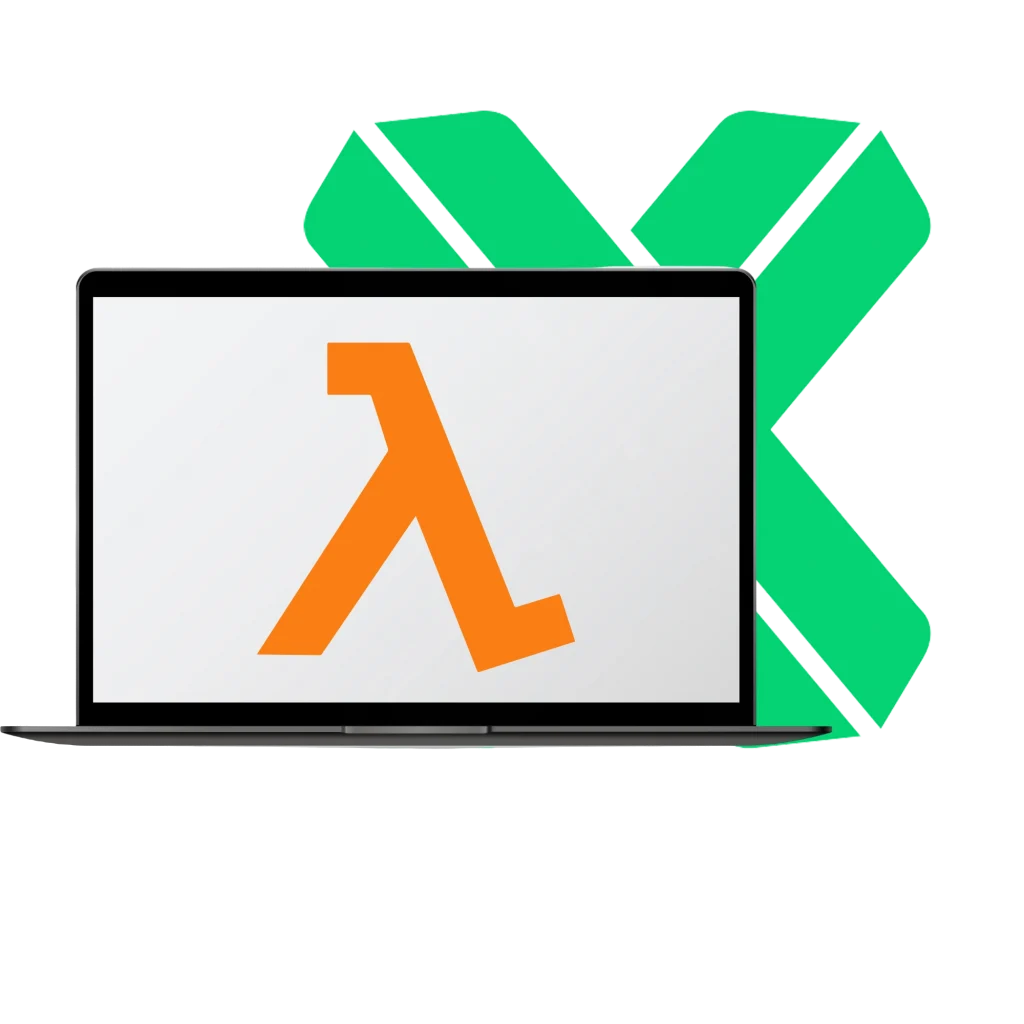AWS LAMBDA DEVELOPMENT COMPANY
Build scalable, serverless applications with AWS Lambda and nearshore talent.
Our AWS Lambda development services provide cost-effective, serverless solutions to power dynamic and scalable applications. We quickly assemble skilled teams, enabling you to run code without managing servers, reduce operational overhead, and scale seamlessly with AWS Lambda.

+200 companies rely on
our 1% Top Talent

AWS Lambda Development we provide
We offer a wide range of AWS Lambda development services, from serverless application development to event-driven architectures and microservices. Explore our key offerings below:
Serverless Application Development
We build serverless applications on AWS Lambda, allowing you to run backend services and APIs without managing infrastructure. Our developers design highly scalable, event-driven architectures to minimize costs and maximize performance.
API Gateway and Lambda Integration
We integrate AWS Lambda with Amazon API Gateway to build scalable, serverless APIs. This setup enables your applications to handle large volumes of API requests with automatic scaling, all while reducing operational complexity.
Lambda Function Development
Our team creates Lambda functions to handle everything from simple data processing to complex, multi-step workflows. Using Python, Node.js, Java, and other supported languages, we deliver optimized code for real-time operations and batch processing.
Event-Driven Architectures
We design event-driven architectures using AWS Lambda, allowing your applications to respond to real-time events from S3, DynamoDB, SNS, and other AWS services. This approach reduces latency and enhances the responsiveness of your applications.
Lambda@Edge for Low-Latency Applications
We leverage Lambda@Edge to run serverless functions closer to your users, improving response times and enabling advanced use cases such as content personalization, A/B testing, and security enhancements.
AWS Lambda Maintenance and Optimization
We provide ongoing support to optimize your Lambda functions, ensuring they are running efficiently. Our team monitors execution times, adjusts memory allocation, and implements optimizations to reduce costs and improve performance.
Why Choose Xpertsoft for AWS Lambda Development
Nearshore Expertise
Our developers are primarily based in Portugal, ensuring seamless collaboration with EU-based clients. With real-time communication and bilingual professionals, we provide efficient development and support for serverless applications on AWS Lambda.
Broad Technical Expertise
Beyond AWS Lambda, our team brings expertise in cloud-native architectures, microservices, and event-driven systems. We offer end-to-end solutions that ensure scalability, reliability, and security for your serverless applications.
Tailored Serverless Solutions
We deliver flexible AWS Lambda development services that align with your business objectives. Whether you need a single serverless function or an entire serverless application, we customize our solutions to meet your unique needs.
The AWS Lambda Ecosystem We Used in Previous Work
Serverless Application Development
Utilize AWS Lambda’s capabilities to build highly scalable, event-driven applications:
- AWS Lambda (for serverless compute)
- Amazon API Gateway (for API management)
- AWS Step Functions (for orchestration)
- Amazon S3 (for event-triggered workflows)
Data Processing and Analytics
Run real-time and batch data processing using Lambda:
- AWS Kinesis (for real-time data streaming)
- Amazon DynamoDB Streams (for event-driven processing)
- AWS Glue (for serverless ETL jobs)
- Amazon Athena (for serverless querying)
Security and Monitoring
Ensure secure and reliable Lambda functions with AWS’s security tools:
- AWS IAM (for role-based access control)
- AWS CloudWatch (for monitoring and logging)
- AWS X-Ray (for distributed tracing)
- AWS Key Management Service (KMS) for encryption
Microservices and Event-Driven Architectures
Build flexible microservices and architectures with Lambda:
- Amazon SNS (for messaging)
- Amazon SQS (for queuing)
- Lambda@Edge (for low-latency serverless functions at the edge)
- AWS EventBridge (for event-driven architectures)
Key Facts to Know About AWS Lambda Development
- Benefits of using AWS Lambda for software development
-
1. Fully Managed, Serverless Architecture
AWS Lambda allows businesses to run code without provisioning or managing servers. This fully managed service automatically scales your application, ensuring that you only pay for the compute time you use, reducing costs and eliminating the need for infrastructure management.
2. Event-Driven Computing
AWS Lambda is designed for event-driven architectures, enabling applications to respond to changes in real time. Whether it’s triggered by file uploads in S3, database updates, or API requests, Lambda ensures quick, automatic responses with low latency.
3. Scalability Without Overhead
Lambda automatically scales your application to handle any number of requests, whether it’s a few per day or millions. This scalability ensures consistent performance, regardless of traffic spikes, while maintaining cost efficiency.
- What AWS Lambda is primarily used for
-
AWS Lambda is primarily used for running serverless applications, automating backend tasks, and processing real-time events. It’s widely adopted for applications such as real-time data processing, dynamic API services, automated backups, and microservices architectures.
- Other reasons for AWS Lambda’s popularity
-
Cost Efficiency: AWS Lambda operates on a pay-per-execution model, meaning you only pay for the compute time your code consumes. This results in significant cost savings, especially for applications with unpredictable or fluctuating workloads.
Cost Efficiency: AWS Lambda operates on a pay-per-execution model, meaning you only pay for the compute time your code consumes. This results in significant cost savings, especially for applications with unpredictable or fluctuating workloads.
Seamless Integration with AWS Services: Lambda integrates seamlessly with other AWS services such as S3, DynamoDB, and Kinesis, enabling businesses to build complex, scalable, and event-driven applications with minimal setup.
Support for Multiple Programming Languages: Lambda supports multiple programming languages, including Python, Node.js, Java, Go, and C#, providing flexibility for developers to write functions in the language they are most comfortable with.
Global Reach with Lambda@Edge: Lambda@Edge allows businesses to run serverless functions at AWS edge locations, reducing latency and enhancing performance for globally distributed applications.
Automatic Scaling: AWS Lambda automatically handles scaling, ensuring your applications can manage increased traffic without manual intervention. This makes it ideal for applications with variable demand, such as APIs, real-time analytics, or IoT platforms.
Simplified Microservices Architecture: AWS Lambda is often used to build and run microservices, enabling developers to break down applications into smaller, more manageable components, which can independently scale and evolve.
• Support for Multiple Programming Languages: Lambda supports multiple programming languages, including Python, Node.js, Java, Go, and C#, providing flexibility for developers to write functions in the language they are most comfortable with.
• Global Reach with Lambda@Edge: Lambda@Edge allows businesses to run serverless functions at AWS edge locations, reducing latency and enhancing performance for globally distributed applications.
• Automatic Scaling: AWS Lambda automatically handles scaling, ensuring your applications can manage increased traffic without manual intervention. This makes it ideal for applications with variable demand, such as APIs, real-time analytics, or IoT platforms.
• Simplified Microservices Architecture: AWS Lambda is often used to build and run microservices, enabling developers to break down applications into smaller, more manageable components, which can independently scale and evolve.
1. Fully Managed, Serverless Architecture
AWS Lambda allows businesses to run code without provisioning or managing servers. This fully managed service automatically scales your application, ensuring that you only pay for the compute time you use, reducing costs and eliminating the need for infrastructure management.
2. Event-Driven Computing
AWS Lambda is designed for event-driven architectures, enabling applications to respond to changes in real time. Whether it’s triggered by file uploads in S3, database updates, or API requests, Lambda ensures quick, automatic responses with low latency.
3. Scalability Without Overhead
Lambda automatically scales your application to handle any number of requests, whether it’s a few per day or millions. This scalability ensures consistent performance, regardless of traffic spikes, while maintaining cost efficiency.
AWS Lambda is primarily used for running serverless applications, automating backend tasks, and processing real-time events. It’s widely adopted for applications such as real-time data processing, dynamic API services, automated backups, and microservices architectures.
Cost Efficiency: AWS Lambda operates on a pay-per-execution model, meaning you only pay for the compute time your code consumes. This results in significant cost savings, especially for applications with unpredictable or fluctuating workloads.
Cost Efficiency: AWS Lambda operates on a pay-per-execution model, meaning you only pay for the compute time your code consumes. This results in significant cost savings, especially for applications with unpredictable or fluctuating workloads.
Seamless Integration with AWS Services: Lambda integrates seamlessly with other AWS services such as S3, DynamoDB, and Kinesis, enabling businesses to build complex, scalable, and event-driven applications with minimal setup.
Support for Multiple Programming Languages: Lambda supports multiple programming languages, including Python, Node.js, Java, Go, and C#, providing flexibility for developers to write functions in the language they are most comfortable with.
Global Reach with Lambda@Edge: Lambda@Edge allows businesses to run serverless functions at AWS edge locations, reducing latency and enhancing performance for globally distributed applications.
Automatic Scaling: AWS Lambda automatically handles scaling, ensuring your applications can manage increased traffic without manual intervention. This makes it ideal for applications with variable demand, such as APIs, real-time analytics, or IoT platforms.
Simplified Microservices Architecture: AWS Lambda is often used to build and run microservices, enabling developers to break down applications into smaller, more manageable components, which can independently scale and evolve.
• Support for Multiple Programming Languages: Lambda supports multiple programming languages, including Python, Node.js, Java, Go, and C#, providing flexibility for developers to write functions in the language they are most comfortable with.
• Global Reach with Lambda@Edge: Lambda@Edge allows businesses to run serverless functions at AWS edge locations, reducing latency and enhancing performance for globally distributed applications.
• Automatic Scaling: AWS Lambda automatically handles scaling, ensuring your applications can manage increased traffic without manual intervention. This makes it ideal for applications with variable demand, such as APIs, real-time analytics, or IoT platforms.
• Simplified Microservices Architecture: AWS Lambda is often used to build and run microservices, enabling developers to break down applications into smaller, more manageable components, which can independently scale and evolve.
Add top 1% devs to
your in-house teams
Tap into the expertise of our top 1% developers. Staff augmentation lets you boost your in-house teams with specialized experts. Expedite timelines without sacrificing output quality.
Here’s how we augment your team

STEP 1
Discovery Call
Share your requirements, budget, and necessary skill sets. We will draft a working timeline and select top developers for your team.
STEP 2
Assembling Your Team
Withindays, we’ll find suitable developers that fit your requirements. We ensure they have the right technical expertise and would be a great cultural fit for your team.
STEP 3
Onboarding and Scaling
After onboarding them, our developers will integrate with your team. Scale your engagement as needed – we’re happy to accommodate your demands.
Get an
entire Team
Looking to bring on more than just a few .NET developers? We’ll assemble a complete crew to support you. Whether it’s full-cycle front and back-end web development, QA, DevOps, UX/UI, or something else. Monitor the team’s performance and manage them as you see fit.
Here’s how you can get a dedicated team

STEP 1
Discovery Call
We’ll learn about your business, organization structure, objectives, budget, timelines, and resource requirements. Then, we can start identifying the ideal talent for you.
STEP 2
Team Assembly and Integration
Once we assemble your dedicated team, we’ll ensure a smooth transition as they integrate with your organization.
STEP 3
Project Kickoff
After onboarding, your team is at your disposal. You’ve now acquired the resources you need without the hassle and high cost that usually comes with recruitment
